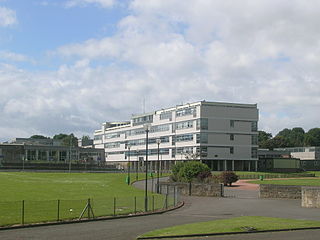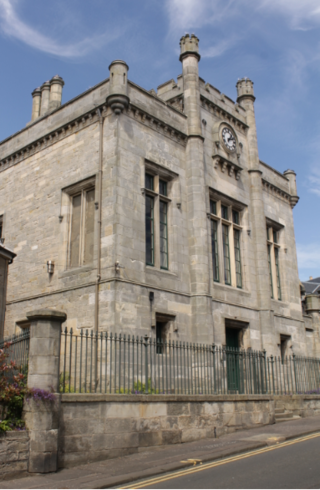
Path House, formerly known as Dunnikier House, is a manor house in the Scottish town of Kirkcaldy in the Fife Council Area. It was listed by Historic Environment Scotland in 1971 as a Category A listed building. [1]

Path House, formerly known as Dunnikier House, is a manor house in the Scottish town of Kirkcaldy in the Fife Council Area. It was listed by Historic Environment Scotland in 1971 as a Category A listed building. [1]
The mansion, located on Nether Street (A921) near Kirkcaldy Harbour, was built in 1692 by John Watson after his marriage to Euphan Orrock, as confirmed by the monograms "IW" and "EO" displayed at various locations on the house. After just a few years, it was transferred to the Oswald family who remodelled it in the early 18th century, when the rear wings may have been added. As the town of Kirkcaldy spread ever nearer to the mansion, the Oswalds decided in the 1790s to build and move to a new house, also called Dunnikier House, further away from the town.
In 1891, the old house was renovated and converted into the rectory of the local parish church. In 1979 the house was acquired by the Fife Health Board, who restored it and renamed it Path House. First serving as a nursing home, it has hosted a health centre since the 1990s.
The three-story building, plastered with harl between natural stone borders, originally had an L-shaped floor plan. The front facade is largely symmetrical with a frieze below a simple cornice. In the interior corner of the south-facing main façade is an engaged round stair tower with a conical roof and weather vane. Next to the tower is the main entrance. Monograms decorate the dormer windows gableheads. The roofs are made of grey slate.

Fife is a council area, historic county, registration county and lieutenancy area of Scotland. It is situated between the Firth of Tay and the Firth of Forth, with inland boundaries with Perth and Kinross and Clackmannanshire. By custom it is widely held to have been one of the major Pictish kingdoms, known as Fib, and is still commonly known as the Kingdom of Fife within Scotland. A person from Fife is known as a Fifer. In older documents the county was very occasionally known by the anglicisation Fifeshire.

Kirkcaldy is a town and former royal burgh in Fife, on the east coast of Scotland. It is about 11.6 miles (19 km) north of Edinburgh and 27.6 miles (44 km) south-southwest of Dundee. The town had a recorded population of 49,460 in 2011, making it Fife's second-largest settlement and the 12th most populous settlement in Scotland.

Dufftown is a burgh in Moray, Scotland. While the town is part of the historic Mortlach parish, the town was established and laid out in the early 19th century as part of a planned new town settlement. The town has several listed 19th century buildings and serves as a regional centre for agriculture, tourism and services. The town is well known for its whisky based economy, as it produces more whisky than any other town in Scotland and is home to several existing and former distilleries.
Cupar is a town, former royal burgh and parish in Fife, Scotland. It lies between Dundee and Glenrothes. According to a 2011 population estimate, Cupar had a population around 9,000, making it the ninth-largest settlement in Fife, and the civil parish a population of 11,183. It is the historic county town of Fife, although the council now sits at Glenrothes.

Dysart is a town and former royal burgh located on the south-east coast between Kirkcaldy and West Wemyss in Fife, Scotland. Dysart was once part of a wider estate owned by the St Clair or Sinclair family. They were responsible for gaining burgh of barony status for the town towards the end of the 15th century.
Kirkcaldy High School is a 6-year co-educational comprehensive state school in Kirkcaldy, Fife, Scotland.

Balwearie High School is a non-denominational comprehensive secondary school at the west end of Kirkcaldy in Scotland. Balwearie serves around 1500 pupils aged from 11 to 18 and includes a Department of Additional Support for children with Additional Support Needs.

Pathhead is an area of Kirkcaldy, in Fife, Scotland. Pathhead was an independent village before it was incorporated into the Royal burgh of Kirkcaldy.

The Mercat Shopping Centre is located in Kirkcaldy, Fife, Scotland, United Kingdom. The Mercat has one anchor store; TK Maxx. The Mercat – including surrounding areas – accounts for at least 30% of all the floorspace in Kirkcaldy town centre, which in total is 46,000-square-metre (500,000 sq ft) and providing as much as 200 shops, making Kirkcaldy the largest shopping area in Fife. The shopping centre was built in two phases between 1972 and 1981–83 with a refurbishment completed in 1997. A proposal to extend the shopping centre for a third phase is pending. In 1996 plans to broadcast an episode of Family Fortunes live from the Mercat Centre were scrapped due to concerns that the event would not be covered by the Centre's insurance company. Les Dennis described the decision as "unfortunate, but sadly unavoidable".

Victoria Hospital is a large hospital situated to the north of the town centre in Kirkcaldy, in Fife, Scotland. As one of two main hospitals in Fife, this serves both the town and surrounding Mid-Fife area. It is managed by NHS Fife.

Dunfermline was a local government district in the Fife region of Scotland from 1975 to 1996, lying to the south-west of the regional capital Glenrothes.

Kirkcaldy was a local government district in the Fife region of Scotland from 1975 to 1996. The district was named after the town of Kirkcaldy but also covered a wider area, including the Fife regional capital of Glenrothes.

Kirkcaldy Town House is a Scandinavian influenced town hall located in Kirkcaldy, Fife, Scotland. The current town house was begun in 1937, from a competition-winning design by architects David Carr and William Howard of Edinburgh. Only the foundations had been put in place before construction was interrupted by the Second World War. Work resumed on the building in 1950 and was completed in two separate phases between 1953 and 1956. The town house would serve as the headquarters of Kirkcaldy Town Council from 1956 to 1975 and then Kirkcaldy District Council from 1975 to 1996. Today, the role of the town house is the headquarters of the local area committee of Fife Council. Kirkcaldy Town House is protected as a Category B listed building.
Oswald is a surname of Scottish, northern English, German and Swiss-German provenance.

James Townsend Oswald was a Scottish politician who sat in the House of Commons between 1768 and 1779.

James Oswald was a Scottish politician who sat in the House of Commons from 1741 to 1768.

Raith, as an area of Fife, once stretched from the lands of Little Raith, south of Loch Gelly, as far as Kirkcaldy and the Battle of Raith was once theorised to have been fought here in 596 AD. Raith Hill, west of Auchtertool and immediately to the east of the Mossmorran fractionation plant, may also be in reference to this wider area or may refer to an actual fort on this hill, distinct to the one naming the area.
James Oswald was a member of the Parliament of Scotland, 1703-1707, representing Kirkcaldy and, later, the member for Dysart Burghs in the House of Commons of Great Britain.

Dysart Tolbooth and Town House is a municipal building in the High Street, Dysart, Fife, Scotland. The structure, which was comprehensively restored in 2009, is a Category A listed building.

Kinghorn Town Hall is a municipal building in St Leonard's Place, Kinghorn, Fife, Scotland. The structure, which is used as holiday accommodation for tourists, is a Category B listed building.